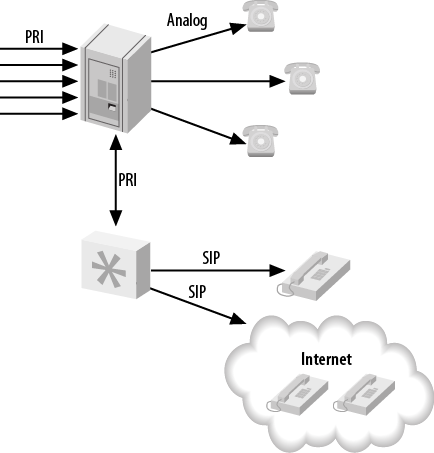A hybrid phone system (Figure 22.2, “Remote hybrid system”) contains the same functionality and hardware as a traditional phone system, with the exception of another system such as Asterisk being attached to it, thereby providing additional capacity and functionality. Adding Asterisk to a traditional system is typically done via a PRI connection. From the viewpoint of the traditional system, Asterisk will look like another phone company (central office, or CO). Depending on the way the traditional system operates and the services available to or from the CO, either Asterisk will deliver calls from the PRI through itself and to the existing PBX, or the existing PBX will send calls over the PRI connection to Asterisk, which will then direct the calls to the new endpoints (phones).
With Asterisk in the picture, functionality can be moved piecemeal from the existing PBX system over to Asterisk, which can take on a greater role and command more of the system over time. Eventually the existing PBX system may simply be used as a method for sending calls to the existing handsets on the agents’ desks, with those being phased out over time and replaced with SIP-based phones, as the wiring is installed and phones are purchased.
By adding Asterisk to the existing system, we gain a new set of functionality and advantages, such as:
Such a system still suffers from a few disadvantages, as all the hardware needs to reside at the call center facility, and we’re still restricted to using (relatively) expensive hardware in the Asterisk system for connecting to the traditional PBX. We’re moving in the right direction, though, and with the Asterisk system in place we can start the migration over time, limiting interruptions to the business and taking a more gradual approach to training users.
